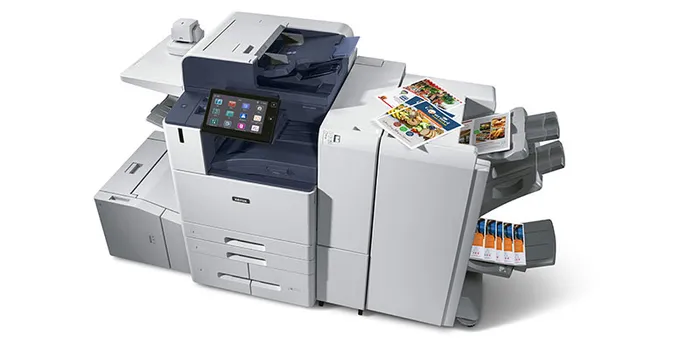
Xerox® Workplace Cloud
The Xerox® Workplace Cloud (XWC) feature provides a cloud-based print solution that enables a remote service to manage many aspects of your device.
Note: The Xerox® Workplace Cloud service is a separate feature from the Xerox® Workplace Cloud authentication method. Xerox® Workplace Cloud authentication options are configured in the Authentication section. For details, refer to Authentication.
Xerox® Workplace Cloud authentication cannot be enabled independently of the Xerox® Workplace Cloud service.
The following scenarios apply:
- Enabling the XWC service does not enable XWC authentication automatically.
- Disabling the XWC service disables XWC authentication if it is enabled. An alert notifies that disablement of XWC authentication will occur.
- Enabling XWC authentication enables the XWC service at the same time.
- Disabling XWC authentication does not disable the XWC service.
To enable Xerox® Workplace Cloud:
-
In the Embedded Web Server, click Properties > Connectivity > Setup.
-
For Remote Management, for Xerox® Workplace Cloud, click Edit.
-
In the Configuration area, click Connection.
-
In the Connection window, configure settings:
- Click the check box for Enable. Note: Xerox® Workplace Cloud is disabled by default.
- For the XWC server, configure the default host address, port number, and path. The default host address is wdm.services.xerox.com. The default port number is 443.
- Click Save.
- The Connection window closes. A Connecting to Xerox® Workplace Cloud window appears.
-
If the initial connection attempt fails, the device performs a retry at the following intervals:
- 10 seconds after the initial attempt
- 60 seconds after the first retry sequence
- 300 seconds after the second retry sequence
Note: After 5–10 seconds, the Cancel option appears. If you click Cancel during the initial connection attempt or during a retry sequence, the device cancels the activity.
-
If the connection attempt fails, a Failed to Connect window appears. A message advises you to check the Authentication Log. For details, refer to the Authentication Log.
-
If the connection is successful, a status of Connected appears in the Xerox® Workplace Cloud status area. The XWC statuses include the following:
- Disabled: This status occurs when XWC is not enabled.
- Site Cannot Be Reached: This status occurs when a connection attempt fails. Verify the settings, then retry the connection.
- Connection Error: This status occurs when a connection attempt fails. Verify the settings, then retry the connection.
- Connected: This status occurs when XWC is enabled and a connection is active. The system timestamp indicates the date and time of the latest connection.
- Configuration File Received: This status occurs when a configuration file is received. The system timestamp indicates the date and time of the latest file received.
Green text indicates a successful connection. Red text indicates a failed connection.
- To view related Web services, in the Related Pages area, for Web Services, click Link. For details, refer to HTTP Web Services.
CONFIGURING IDENTITY PROVIDER (IDP) – VALIDATE ON CLOUD AUTHENTICATION SETTINGS
When you configure Identity Provider (IdP) authentication, users prove their identity by typing a user name and choosing one of the sign-in options, such as SFA (Single-Factor Authentication) or MFA (Multi-Factor Authentication), which do not require a password and are made available by the IdP. The device compares the user credentials to the information that is stored in the user database.
The Login Methods page in the Embedded Web Server provides links to authentication and personalization configuration settings.
1. In the Embedded Web Server, click Properties > Login/Permissions/Accounting > Login Methods.
2. Set the login method to Identity Provider (IdP) – Validate on Cloud. For details, refer to Setting the Login Method for the Control Panel.
3. In the Configuration Settings table, configure options for local authentication:
- To configure identity provider settings, for Identity Provider Endpoint, click Edit. For details, refer to Identity Provider Endpoint.
- To auto-populate IdP login from user certificate, for Auto-Populate IdP Login, click Edit. In the Auto-Populate IdP Login window, to enable or disable the Acquire email address from the user certificate to auto-populate the IdP login option, click the toggle button, then click OK.
- To add user information to the device user database, for Device User Database, click Edit. For details, refer to Adding, Editing, or Viewing User Information in the User Database.
- To specify the account and password requirements for a locally authenticated user, for Device Account Requirements, click Edit. For details, refer to Specifying User Password and Account Requirements.
- To configure card reader policies, for Card Reader Setup, click Edit. For details, refer to Configuring the USB Card Reader Disconnection Policy.
- To select the trusted client certificates to validate login first, for the First Priority Client Cert Validation Pool, click Edit. In the Edit Client Certificate Priority window, select the Smart Card option to log in with a Smart Card Authentication using the Certificate Based Authentication sign-in option, then click OK.
- If needed, specify the method that the printer uses to acquire the email address of users. For Acquiring Logged in User’s Email Address, click Edit. For details, refer to Specifying the Method the Printer Uses to Acquire Email Address of Users.
- To customize the title and instruction text that appears on the blocking screen, for Customize Blocking Screen, click Edit. For details, refer to Customize Blocking Screen.
- To enable the USB device reset from the control panel, for USB Reset Policy, click Edit. To enable or disable Allow the USB reset from the Touch Control Panel option, click the toggle button in the USB Reset Policy window, then click OK.
- To enable or disable the device authentication, for On-Device Authentication, click Edit. In the On-Device Authentication window, to enable or disable the On-Device Authentication option, click the toggle button, then click OK.
- To enable personalization for logged-in users, for Personalization, click Edit. For details, refer to Enabling Personalization.
- To view or delete personalization profiles, for Personalization Profiles, click Edit. For details, refer to View and Deleting Personalization Profiles.
- To provide information about your LDAP server for personalization, for LDAP Servers, click Edit. For details, refer to Configuring LDAP Server Optional Information.
- To enable or disable the logout prompt at the control panel, for Log Out Confirmation, click Edit. For details, refer to Disabling the Logout Confirmation Prompt.
- To enable and configure proxy server settings, for Proxy Server, click Edit. For details, refer to Proxy Server.
- To enable and configure an EIP authentication app, for EIP Authentication, click Edit. For details, refer to Configuring an EIP Authentication App.
- To enable and configure login using cards, for Card Credential Configuration, click Edit. In the Card Credential Configuration window, to enable or disable Allow walkup users to login using the cards option, click the toggle button, then click Save.
- To view or configure any actions on card profiles for a user, for Card Credential Profiles, click Edit. The Card Credential Profiles window displays the details of users having registered cards.

